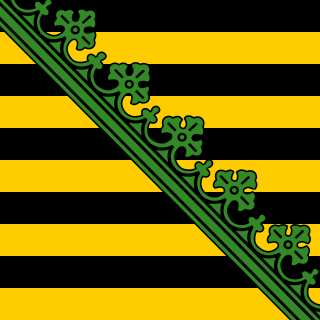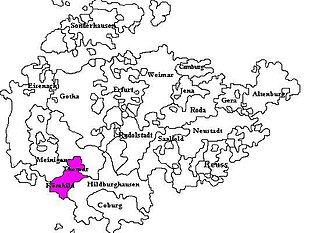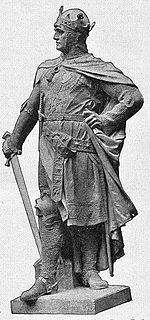Related Research Articles

The Prince-Archbishopric of Bremen, also Archbishopric of Bremen, — not to be confused with the former Archdiocese of Bremen, and the modern Archdiocese of Hamburg, founded in 1994 — was an ecclesiastical principality (787–1566/1648) of the Holy Roman Empire, which after its definitive secularization in 1648, became the hereditary Duchy of Bremen. The prince-archbishopric, which was under the secular rule of the archbishop, consisted of about a third of the diocesan territory. The city of Bremen was de facto and de jure not part of the prince-archbishopric. Most of the prince-archbishopric lay rather in the area to the north of the city of Bremen, between the Weser and Elbe rivers. Even more confusingly, parts of the prince-archbishopric belonged in religious respect to the neighbouring diocese of Verden, making up 10% of its diocesan territory.

Anno II was Archbishop of Cologne from 1056 until his death. From 1063 to 1065 he acted as regent of the Holy Roman Empire for the minor Emperor Henry IV. Anno is venerated as a saint of the Catholic Church.
![Bruno the Great Archbishop of Cologne and Duke of Lotharingia[[Category:articles with short description]][[Category:Short description is different from Wikidata]]](https://upload.wikimedia.org/wikipedia/commons/e/e0/Bruno_the_Great.jpg)
Bruno the Great was Archbishop of Cologne from 953 until his death and Duke of Lotharingia after 954. He was the brother of Otto I, Holy Roman Emperor.
Adolf of Altena, Adolf of Berg or Adolf of Cologne, was Archbishop of Cologne from 1193 to 1205.

Hilduin was Bishop of Paris, chaplain to Louis I, reforming Abbot of the Abbey of Saint-Denis and an author. He was one of the leading scholars and administrators of the Carolingian empire.
Herman II was a member of the Conradine dynasty. He was duke of Swabia from 997 to his death. Between January and October 1002 Herman II attempted, unsuccessfully, to become king of Germany.

Henry IV was the duke of Limburg and count of Berg from 1226 to his death. He was the son of Waleran III, count of Luxembourg and duke of Limburg, and Cunigunda, daughter of Frederick I, Duke of Lorraine.
The Ezzonids were a dynasty of Lotharingian stock dating back as far as the ninth century. They attained prominence only in the eleventh century, through marriage with the Ottonian dynasty of Holy Roman Emperors. Named after Ezzo, Count Palatine of Lotharingia from 1015 to 1034, they dominated the politics of the middle and lower Rhine and usually represented the royal interests. Under the Salian Emperors, they even briefly held the dukedoms of Swabia, Carinthia, and Bavaria.

The Duchy of Saxe-Wittenberg was a medieval duchy of the Holy Roman Empire centered at Wittenberg, which emerged after the dissolution of the stem duchy of Saxony. The Ascanian dukes prevailed in obtaining the Saxon electoral dignity until their duchy was finally elevated to the Electorate of Saxony by the Golden Bull of 1356.

Conrad of Wittelsbach was the Archbishop of Mainz and Archchancellor of Germany from 20 June 1161 to 1165 and again from 1183 to his death. He was also a cardinal of the Roman Catholic Church.
Siegfried I was the Abbot of Fulda from 25 December 1058 until 6 January 1060, and from January 1060 until his death in February 1084, he was Archbishop of Mainz.

Saxe-Römhild was an Ernestine duchy in the southern foothills of the Thuringian Forest. It existed for only 30 years, from 1680 to 1710.
Frederick of Saxe-Lauenburg (1554–1586), was a cathedral canon at Strasbourg Minster, chorbishop at Cologne Cathedral and cathedral provost (Dompropst), a function including the presidency of the chapter, at Bremen Cathedral.

Henry I of Nassau-Siegen, German: Heinrich I. von Nassau-Siegen was Count of Nassau-Siegen, a part of the County of Nassau, and ancestor of the House of Nassau-Siegen. He comes from the Ottonian branch of the House of Nassau.

Henry of Saxe-Lauenburg was a Prince-Archbishop of Bremen, then Prince-Bishop of Osnabrück, then Prince-Bishop of Paderborn.

Albert II, Margrave of Brandenburg was a member of the House of Ascania. He was Margrave of Brandenburg from 1205 until his death in 1220.
Henry IV, Count of Waldeck was the ruling Count of Waldeck from 1305 to 1344. He was the second ruling count named "Henry", which is why some authors call him "Henry II". However, two earlier non-ruling members of the House of Waldeck are usually called Henry II and Henry III, and the subject of this article is commonly called Henry IV.

The Coup of Kaiserswerth in 1062 was a hitherto unprecedented action of several secular and ecclesiastical Princes of the Holy Roman Empire under the leadership of Archbishop Anno II of Cologne against Empress Agnes, ruling on behalf of her under-age son, King Henry IV, and against her chosen sub-regent, Bishop Henry II of Augsburg. By kidnapping the young king and enforcing the handover of the Imperial Regalia, the group gained control of the reins of power in the Empire.
Countess Mechthild of Sayn, also called Mechthild of Landsberg, Mechtild, Mechtildis or Mathilde, was the wife of Henry III of Sayn. She was an important figure in the Late Middle Ages because of her religious foundations (Stiftungen).
References
- ↑ Lacomblet, Theodor Joseph (1966). Urkundenbuch für die Geschichte des Niederrheins. Aalen. p. 153.